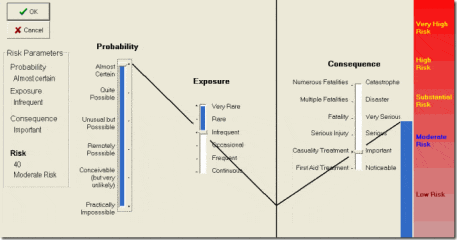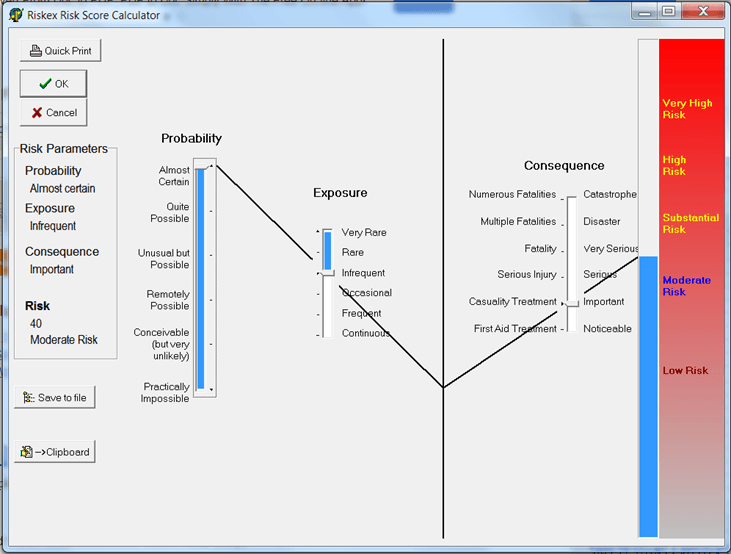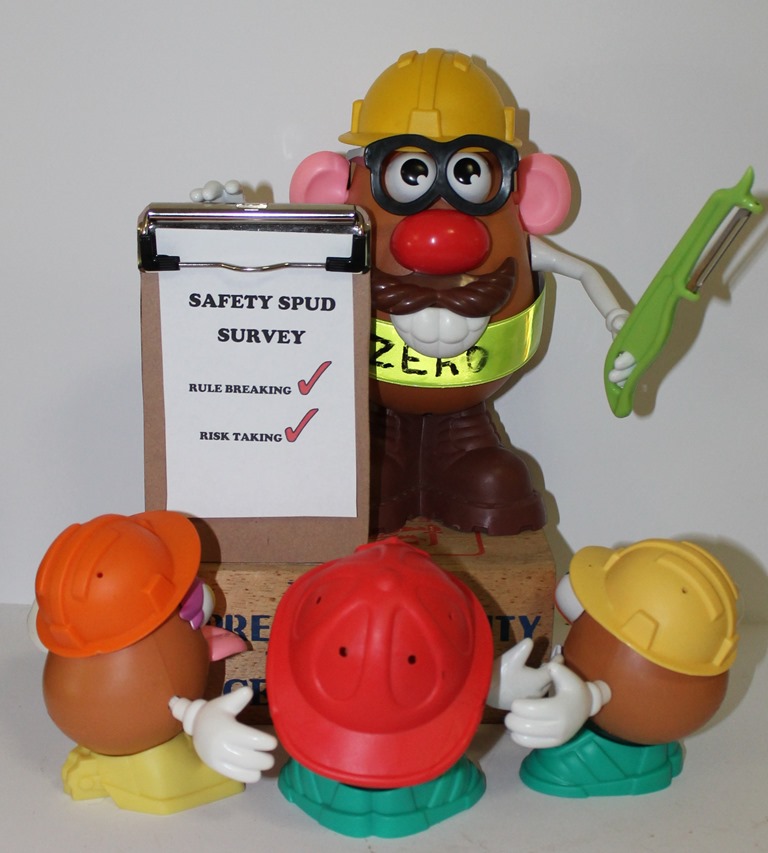Electronic Risk Score Calculator
I was given this risk assessment tool over 20 years ago. I thought it was totally awesome and it was one of the first things I published on this blog over 12 years ago (even before all the safety slogans and safety fail photos!) It was high tech in it’s day, back when if someone said “they needed an app” – they meant a quick sleep. (if you must have an iphone risk score app – click here).
Since then it’s been downloaded over 250,000 times! At first I was chuffed at the number of people I’ve been able to help out and all the thankyou emails I received. But now I’m shuddering to think of the damage it may have caused? This tool still generates a large proportion of all the emails I get. Questions like: “What is the algorithm it uses?”, “Why won’t it work on a Mac?” “When are you going to make it into and app?”, “Can criteria be weighted?”, “Can the criteria be changed?” etc etc.
But, an email yesterday prompted this post. It said: “This tool is flawed, our team used it in a recent safety meeting to assess a factory hazard and every person got a completely different score!”. YES!! Of course it’s flawed and yet demonstrates the concept of risk perception perfectly!
If you don’t want to read the rest of this post, I understand and here it is, but some great learning follows if you are interested:
Download Electronic Risk Score Calculator: Riskex Risk Score Calculator 1
We even developed a Cost Justification Calculator for your risk controls HERE
Thanks for choosing to keep reading……..It staggers me that people think that risk can be calculated objectively and to 3 decimal places.
As Dr Rob Long writes in Objectivity, Audits and Attribution When Calculating Risk:
Any assessment of risk is an emotional, arational and subjective exercise. Risks are not objective but are ‘attributed’. One person is anxious about one activity when the person beside them is not. Some people are confident with some high level risks and others are much more cautious…. The idea that humans assess risk objectively or just calculate risk based on the common criteria in any risk matrix (exposure, frequency, probability and consequence) is not supported by the evidence.
We know from social psychology that the way we attribute risk to various activities is in part affected by many cognitive biases. The ‘availability heuristic’ and ‘probability neglect’ are two mechanisms that powerfully affect the way we attribute risk. Depending what is ‘available’ to our memory or our senses we magnify, distort or dismiss the value of certain risks. We neglect the probability of something happening depending how distant our emotions are from the subject. This is also called the ‘recency effect’, people tend to overestimate risk if their experience of an event is more recent and personal.
It also might be good to bring outsiders and novices on audits and assessment walks, just because they don’t think like you. There is nothing more dangerous to an audit or assessment than the problem of ‘confirmation bias’. We all like to have the agreement of others and the back slapping that eschews but this also limits our capability to think ‘outside the box’. Maybe the apparently ‘dumb’ questions of others unfamiliar with your auditing bias are just what you need, particularly if you have been doing the same auditing processes for some time.
Further, in How to Do the Best Risk Assessment Dr Long says:
A risk assessment is not a mathematical or engineering exercise but rather a human social process that should focus more on conversation than some shifting of colours and scores that have no meaning. Risk assessment should be a conversation and dialogue about the subjective understanding of uncertainties. It was Karl Weick who constantly stated: ‘I can’t know what I believe until I see what I do’. This means, as humans we have unlimited hindsight but very limited foresight. When we talk about what we have done, we rationalize backwards, when we talk about what we might do we imagine what might happen. Humans are not omnipotent, omnipresent and omniscient. Setting zero goals may be good for god but doesn’t make sense for humans.
The risk assessment exercise is a thinking conversation and strategic task, if we think it is an engineering and mathematical task, we are in trouble. The notion of ‘controlling’ the unexpected and uncertainty actually diminishes any thought about adaptability and resilience. So whilst it is helpful to talk about the future, this helps us imagine and process possibilities but not certainties. Rather, having a focus on resilience and skills of adaptability we might be more able to manage the unexpected.
The best risk assessment should have a section at the end for thinking, learning, conversation outcomes, dialogue, adaptability and resilience thinking. What is the discourse of the risk assessment tools you use in your workplace? What kind of thinking do they drive? Are they making you adaptable and resilient or closed and fixed? Are we any safer by trying to predict the future? Or are we making our workplace more ‘fragile’ (Taleb) to surprise so that when that surprise comes, things fall apart rather than hold together?
Rob Sams, in his article Risk is About People, Not Just Objects, also shares my concerns:
‘Risk assessment’ is a daily routine for many health and safety professionals. We lead risk assessment teams, write up risk assessment processes, ‘teach’ people how to do risk assessments or report on the outcomes of risk assessments. As I have written about previously (https://safetyrisk.net/i-wish-i-had-thought-of-that/), ‘Risk assessment’ is also a cornerstone of modern health and safety legislation in Australia, it is enshrined in so much of what we do in health and safety.
But I wonder if our approach to ‘risk assessment’ works? There have been times in the past where our approach to ‘risk assessment’ in health and safety has troubled me, and I wonder if other health and safety professionals have felt the same?
STILL NOT CONVINCED? FAIR ENOUGH – HAVE FUN WITH THIS – THAT’S ALL ITS REALLY GOOD FOR:
Download Electronic Risk Score Calculator: Riskex Risk Score Calculator 1
Risk Score Nomograms are based on OHS Risk Assessment AS/NZS 4804:2001 and contained in HB205-2004 OHS Risk Management Handbook. The Ratings used for the Risk Calculation have been adapted from Fine, Journal of Safety Research 1971 page-159. The risk assessment calculator is intended as a guide to identify level of risk. The risk score so calculated should be interpreted with caution. It should only be used as a basis for consistency of reasoned judgment.
- Consequences are defined as the most probable result of the potential incident.
- Exposure is defined as the frequency of exposure to the hazard.
- Likelihood is that the complete sequence of events leading up to consequences will occur upon exposure to the hazard
The aim of the Risk Rating or Scoring System is to have a consistent standard across an organisation for rating risks. This is a legislative requirement in most jurisdictions and a criteria for self insurers to be met as part of an organisations self insurer licence. The outcome of applying a consistent risk rating system across the organisation will be improved decision making in choosing appropriate, adequate risk control measures leading to more effective management of risks and prevention of injury and property and environmental damage.
Download Electronic Risk Score Calculator: Riskex Risk Score Calculator 1
Also checkout our Electronic Cost Justification Calculator HERE





Admin says
cant help you there sorry, its over 20 years old and Ive lost touch with the developer
Paul Jones says
Is it possible to supply the calculations used to determine the final risk score displayed by the calculator? I would love to use this tool in our company but need to show the logic of the calculation.